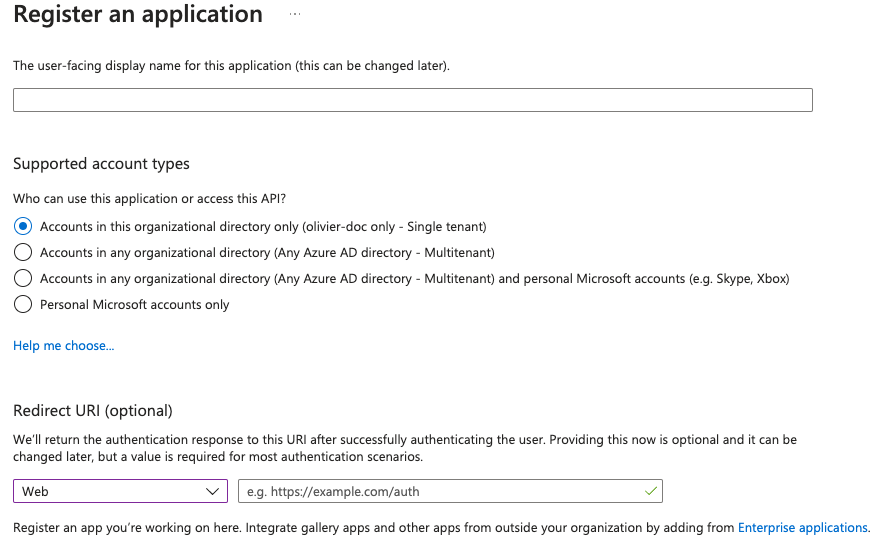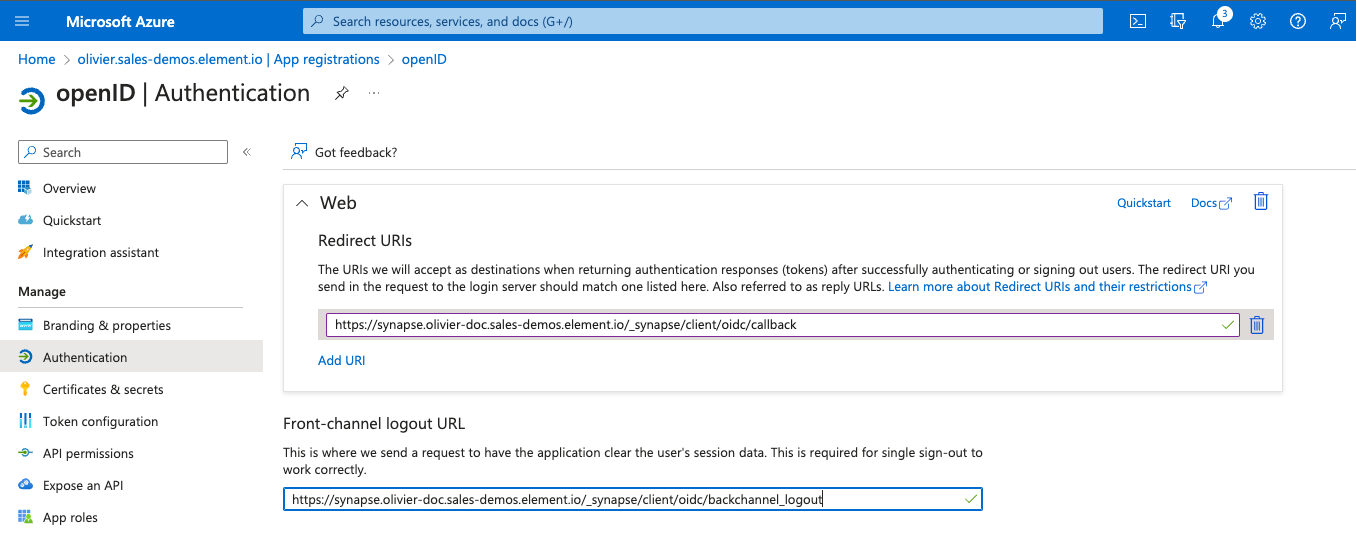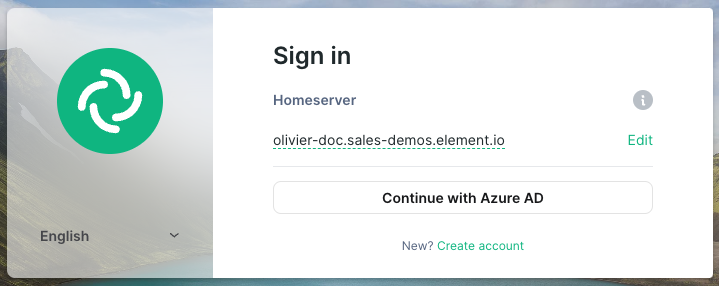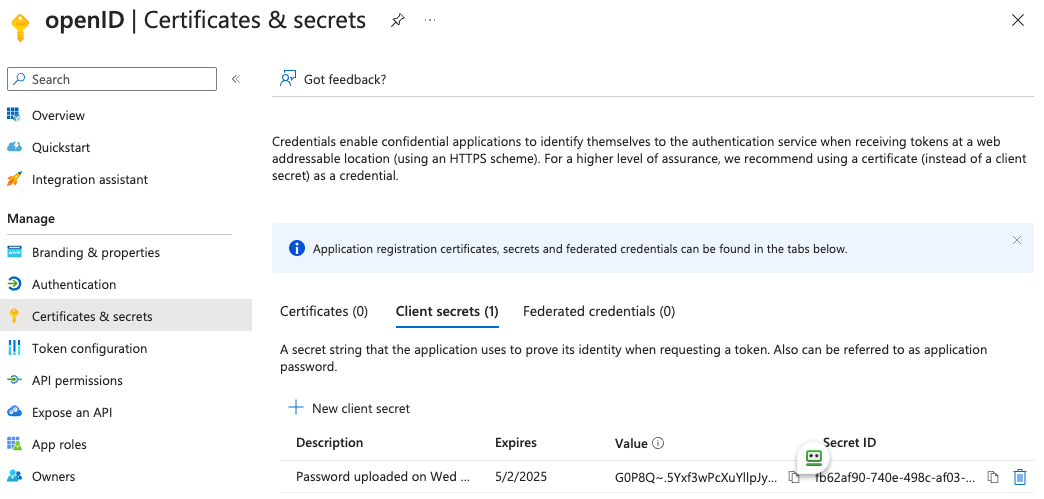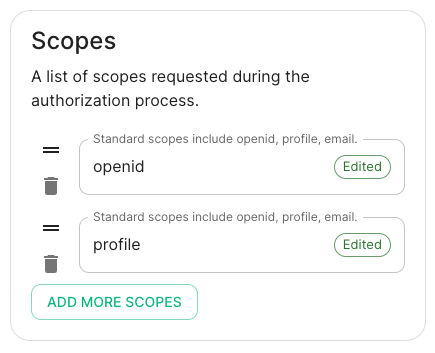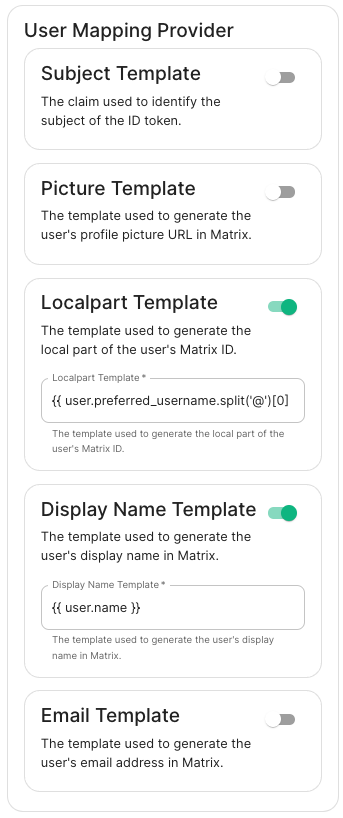Setting up Delegated Authentication with SAML on Microsoft Azure (WIP)
Before setting up the installer, you have to configure Microsoft Azure Active Directory.
Set up Microsoft Azure Active Directory
You need to create anApp registration.You have to selectRedirect URI (optional)and set it to https://matrix.your-domain.com/_synapse/client/oidc/callback
For the bridge to be able to operate correctly, navigate to API permissions, add Microsoft Graph APIs, choose Delegated Permissions and add
openidprofile
Remember to grant the admin consent for those.
To setup the installer, you'll need
theApplication (client) IDtheDirectory (tenant) IDa secret generated fromCertificates & secretson the app.
Configure the installer
Add an OIDC provider in the 'Synapse' configuration after enabling Delegated Auth and set the following fields in the installer:
Allow Existing Users: if checked, it allows a user logging in via OIDC to match a pre-existing account instead of failing. This could be used if switching from password logins to OIDC.Authorization Endpoint: the oauth2 authorization endpoint. Required if provider discovery is disabled.https://login.microsoftonline.com/<Directory (tenant) ID>/oauth2/v2.0/authorizeBackchannel Logout Enabled: Synapse supports receiving OpenID Connect Back-Channel Logout notifications. This lets the OpenID Connect Provider notify Synapse when a user logs out, so that Synapse can end that user session. This property has to bet set tohttps://your-domain/_synapse/client/oidc/backchannel_logoutin your identity provider
Client Auth Method: auth method to use when exchanging the token. Set it toClient Secret Postor any method supported by your IdpClient ID: yourApplication (client) IDDiscover: enable/disable the use of the OIDC discovery mechanism to discover endpointsIdp Brand: an optional brand for this identity provider, allowing clients to style the login flow according to the identity provider in questionIdp ID: a string identifying your identity provider in your configurationIdp Name: A user-facing name for this identity provider, which is used to offer the user a choice of login mechanisms in the Element UI. In the screenshot bellow,Idp Nameis set toAzure AD
Issuer: the OIDC issuer. Used to validate tokens and (if discovery is enabled) to discover the provider's endpointshttps://login.microsoftonline.com/<Directory (tenant) ID>/v2.0Token Endpoint: the oauth2 authorization endpoint. Required if provider discovery is disabled.Client Secret: your secret value defined under "Certificates and secrets"
Scopes: add every scope on a different lineThe openid scope is required which translates to the Sign you in permission in the consent UIYou might also include other scopes in this request for requesting consent.
User Mapping Provider: Configuration for how attributes returned from a OIDC provider are mapped onto a matrix user.Localpart Template: Jinja2 template for the localpart of the MXID. Set it to{{ user.preferred_username.split('@')[0] }}for Azure ADDisplay Name Template: Jinja2 template for the display name to set on first login. If unset, no displayname will be set. Set it to{{ user.name }}for Azure AD
Other configurations are documentedhere.
With an account with enough rights, go to : Enterprise Applications Portal
- Click on
New Application - Click on
Create your own applicationon the top left corner - Choose a name for it, and select
Integrate any other application you don't find in the gallery - Click on "Create"
- Select
Set up single sign on - Select
SAML -
EditonBasic SAML Configuration - In
Identifier, add the following URL :https://<synapse fqdn>/_synapse/client/saml2/metadata.xml - Remove the default URL
- In
Reply URL, add the following URL :https://<synapse fqdn>/_synapse/client/saml2/authn_response - Click on
Save -
EditonAttributes & Claims - Remove all defaults additional claims
- Click on
Add new claimto add the following claims. The UID will be used as the MXID, the - value here is mostly a suggestion :
- Name:
uid, Transformation :ExtractMailPrefix, Parameter 1 :user.userprincipalname - Name:
email, Source attribute :user.mail - Name:
displayName, Source attribute :user.displayname
- Name:
- Click on
Save - In
Users and Groups, add groups and users which may have access to element
Configure the installer
Add a SAML provider in the 'Synapse' configuration after enabling Delegated Auth and set the following fields in the installer:
-
Allow Unknown Attributes - Under
Attribute Map, select theIdentifier-URN:Oasis:Names:TC:SAML:2.0:Attrname Format:Basic - Under
Mappingadd the following mappings:- From:
Primary EmailToemail - From
First NameTofirstname - From
Last NameTolastname
- From:
- Certificates????
- Encryption??????
- Under Entity, enter a description, the Entity ID (from Azure) and a name.
- Under User Mapping Provider select the following:
- MXID Mapping: Dotreplace
- MXID Source Attribute: uid
- Under Metadata URL, add the metadata URL from Azure

